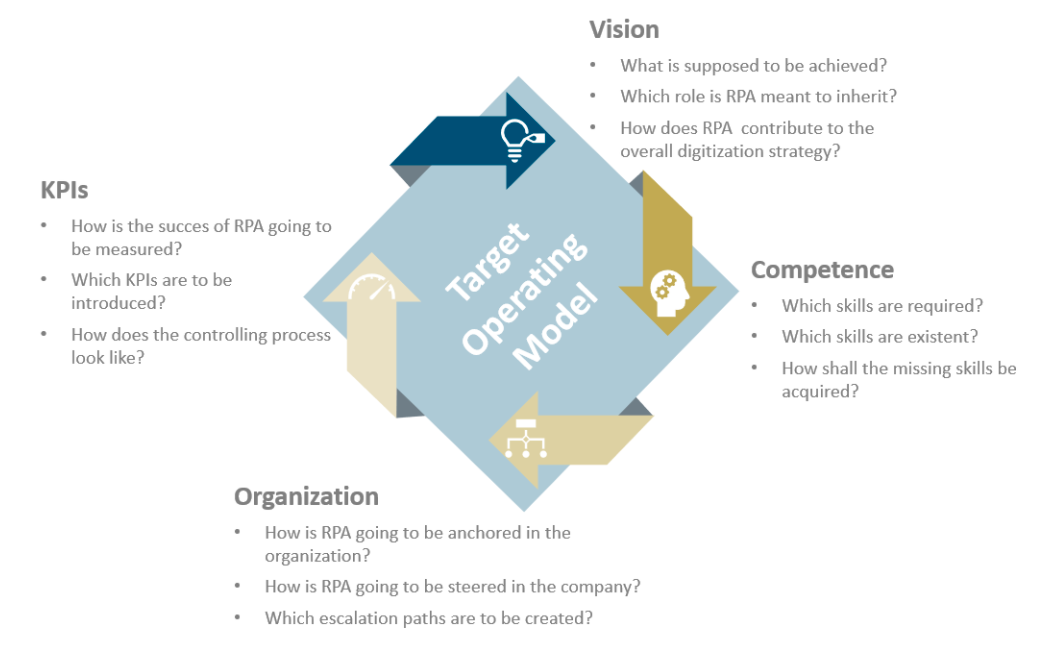When it comes to modern business environment, where speed and flexibility are critical, Robotic Process Automation (RPA) is both a trend of the future and an urgent need. RPA allows human resources to be allocated to more advanced and creative projects by automating repetitive, routine tasks. But simply implementing RPA occasionally is not enough.
Organizations must create a thorough RPA strategy that is in line with their overall business goals if they want to acquire a competitive advantage. Our goal today is to offer a methodical way to develop an RPA strategy that achieves optimization rather than just automation.
What Is an RPA Strategy and Why Does it Matter?
When you decide to implement robotic process automation (RPA), it’s tempting to dive right in and automate all your repetitive tasks. However, starting with an RPA strategy is essential. This strategic approach acts as a roadmap, guiding you from the initial planning stages to full-scale digital transformation.
Imagine a hospital aiming to streamline its administrative processes through robotic process automation (RPA). While the idea of automating tasks like patient scheduling and billing is enticing, diving in without a clear strategy could lead to inefficiencies and missed opportunities. An RPA strategy serves as the hospital’s roadmap for implementing automation effectively.
Simply put, an RPA strategy is a detailed plan that outlines how your organization will implement RPA into its workflows. It focuses on three key elements: people, processes, and technology.

- People: Assessing your workforce’s skills and providing necessary training ensures they can effectively utilize RPA tools.
- Processes: Analyzing your workflows helps identify tasks that can be automated, streamlining operations and reducing manual errors.
- Technology: Evaluating your IT capabilities ensures that your infrastructure can support RPA implementation and integration.
Now thinking about why it matters, here’s a brief explanation..
- Aligned Expectations: A strategy ensures that everyone understands the goals of RPA and how it fits into the overall business objectives.
- Avoids Skill Shortcomings: It helps identify skill gaps and ensures that your team is adequately trained to leverage RPA technology.
- Mitigates Pitfalls: Establishing a governance structure ensures that RPA initiatives are well-managed, risks are mitigated, and compliance requirements are met.
- Ensures Success: Engaging stakeholders from the beginning ensures that RPA initiatives are aligned with the needs of the business and receive the necessary support.
Starting with an RPA strategy allows you to approach automation strategically and maximize its benefits for your organization. It provides a clear path forward, ensuring that your automation efforts are well-coordinated and aligned with your overall business objectives.
What Are the Key Components of RPA Strategy
When devising your RPA strategy, focusing on four key elements can significantly enhance its effectiveness. These elements ensure that your automation plan is well-structured and aligned with your organizational goals.

1. Vision
- Clear Direction: A clear vision lays a solid foundation for your RPA strategy, defining your expectations and aligning them with your team’s goals.
- Alignment with Business Objectives: It helps answer critical questions like “What are we trying to achieve with RPA?” and ensures that your automation efforts are in line with broader business objectives.
2. Competence
- Identifying Necessary Skills: RPA success hinges on having the right skills. Assess your team’s competencies and identify any gaps that need to be filled.
- Skill Acquisition: Determine how you can acquire the skills needed for RPA. This could involve training your existing team or hiring new talent.
3. Organization
- Effective Management: Decide how you will manage your RPA efforts. This could involve setting up a Center of Excellence (CoE) or delegating responsibilities (Grassroot) across different teams.
- Centralized vs. Decentralized Approach: Choose between managing RPA centrally or dispersing responsibilities. Answering the question, “Who will manage the RPA?” is crucial for success.
4. KPIs
- Measuring Success: Determine the key performance indicators (KPIs) that will measure the success of your RPA strategy.
- ROI Assessment: Before investing in RPA, understand the ROI it will deliver. This involves setting KPIs that help answer the question, “How will the success of RPA be measured?”
By focusing on these essential elements, you can ensure that your RPA strategy is well-rounded, effectively managed, and aligned with your organizational objectives.
Why do You need an RPA Strategy for Your Business Growth?
While the benefits of Robotic Process Automation (RPA) are clear, the necessity of a well-defined strategy for its implementation cannot be overstated. Your RPA strategy serves as the blueprint for your digital transformation journey.
While it might be tempting to launch a single software bot for a few tasks, having a strategy is crucial for long-term success. Here’s why:
1. Avoid Wasting Time, Resources, and Money
Without an RPA strategy, you might not know how to effectively integrate automation into your workflows. This could result in investing resources into areas where automation doesn’t deliver the most value. A strategy helps identify the right areas for automation, maximizing your return on investment.
2. Clearly Define Goals and Expectations:
Business automation is exciting, but without shared goals, some stakeholders may be left unsatisfied. An RPA strategy provides a platform to discuss and align automation goals, ensuring everyone is on the same page.
3. Enable Future Scalability
Your RPA strategy should lay a foundation for future growth. By establishing solid competencies and empowering your organization to embrace automation, you set the stage for scalable automation solutions. Remember, how well you start can determine your future scalability.
4. Enhance Operational Efficiency
An RPA strategy focuses on optimizing processes, leading to enhanced operational efficiency. By identifying repetitive tasks that can be automated, you can streamline workflows and reduce manual errors, ultimately improving your bottom line.
5. Drive Innovation and Competitiveness
Implementing RPA strategically can help your business stay ahead of the curve. By automating mundane tasks, your team can focus on more strategic and innovative projects, keeping your business competitive in the market.
An RPA strategy is not just about adopting automation; it’s about future-proofing your business and unlocking new opportunities for growth and innovation. By investing in a robust RPA strategy, you can ensure that your business remains agile, efficient, and competitive in today’s dynamic business landscape.
Building a Future-Proof RPA Strategy
Adopting robotic process automation (RPA) is a significant step, but your RPA strategy should aim for greater heights. A long-term RPA strategy should embody the principles of digital shift, which involves adapting existing business processes to thrive in today’s digital age. This approach signifies a fundamental shift in how we work and interact with customers.
To truly expand the horizons of automation, your strategy should encompass a broader array of digital transformation technologies.
- RPA is the first step in digital transformation, but it should not be the only one.
- Digital transformation involves adapting to the demands of the digital age and reimagining business processes.
- Intelligent process automation (IPA) combines RPA with artificial intelligence (AI), optical character recognition(OCR), and other technologies to enhance automation capabilities.
- IPA enables automated solutions to make decisions, adding flexibility to end-to-end automation.
- Incorporating IPA and analytics into your long-term RPA strategy can lead to more efficient and effective automation solutions.
Conclusion
We know that strategizing is certainly not as satisfying as witnessing your software robot complete its first task. But, as you can see, developing an RPA strategy is crucial to your automation achieving success. Taking the time to scope out the aspects of your project—your vision, competence, organization, and KPIs—it will help you avoid wasting time and money, define your goals, and scale your strategy for the future.
Sunflower Lab has multiple locations to better serve our clients. Robotic process automation services Ohio, robotic process automation services New Jersey, and robotic process automation services New York all designed specifically to accommodate the needs in each unique market. Reach out to one of our RPA specialists today to know more about our Robotic Process Automation Services.
Drive Success with Our Tech Expertise
Unlock the potential of your business with our range of tech solutions. From RPA to data analytics and AI/ML services, we offer tailored expertise to drive success. Explore innovation, optimize efficiency, and shape the future of your business. Connect with us today and take the first step towards transformative growth.
You might also like
Stay ahead in tech with Sunflower Lab’s curated blogs, sorted by technology type. From AI to Digital Products, explore cutting-edge developments in our insightful, categorized collection. Dive in and stay informed about the ever-evolving digital landscape with Sunflower Lab.




